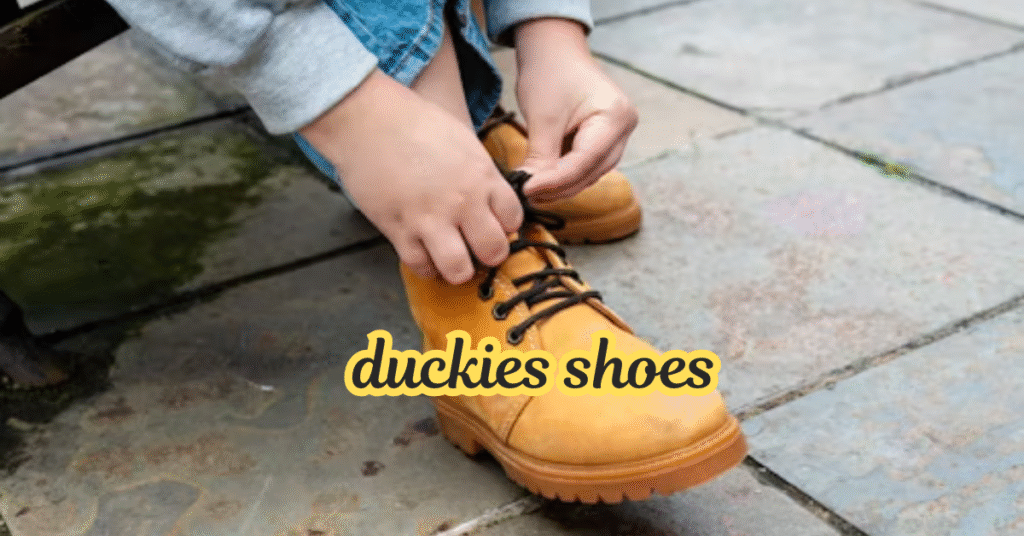In the world of footwear, certain names rise above simple utility and become part of cultural memory. Duckies shoes’s are one of those rare examples. Known for their practicality, quirky appeal, and surprising longevity, Duckies shoes’s are not just footwear; they are a bridge between functional necessity and understated style. If you’re searching to understand what Duckies shoes’s are, why they matter, and how they’ve managed to remain relevant across generations, this article provides the clarity you need—right from their origins to their use today. Within the first glance, you’ll know Duckies shoes’s are more than “rain gear.” They embody resilience, comfort, and a design philosophy that values both protection and character
The Origins of Duckies Shoes
The story of Duckies shoes’s begins with a simple problem: keeping feet dry while maintaining comfort. In regions where rainfall was frequent and unpredictable, early rubber footwear provided an answer. Duckies emerged as a lighter, more approachable version of bulky rain boots. Unlike industrial-grade galoshes, Duckies were designed for everyday wear, blending waterproofing with a slip-on convenience that appealed to both adults and children.
Their early popularity can be traced to agricultural communities and coastal towns, where wet conditions made waterproof footwear essential. Over time, Duckies became widely recognized as an affordable, dependable option for anyone seeking shoes that could withstand puddles, mud, or wet sidewalks without sacrificing comfort.
Why Duckies Shoes Are Different
At first glance, Duckies may resemble other waterproof shoes, but several factors set them apart:
- Material Composition – Duckies traditionally use a combination of rubber soles and flexible uppers, ensuring waterproof coverage without rigid discomfort.
- Weight Balance – Unlike heavy-duty boots, they are light enough for daily wear, suitable for children, students, and workers alike.
- Slip-On Convenience – With no complex lacing or zippers, Duckies can be slipped on quickly, which makes them highly practical.
- Cultural Nostalgia – For many, Duckies shoes’s are tied to memories of school days, rainy mornings, and practicality handed down from parents.
Table: Key Features of Duckies Shoes
| Feature | Duckies Shoes Benefit | Why It Matters |
|---|---|---|
| Waterproof Design | Keeps feet dry in rain and puddles | Essential for wet or muddy environments |
| Lightweight Build | Reduces fatigue during daily wear | Comfortable for extended use |
| Slip-On Style | Easy to put on and remove | Saves time, especially for children |
| Affordable Pricing | Accessible to a wide audience | Budget-friendly footwear option |
| Durable Soles | Withstand repeated exposure to moisture | Longer lifespan than regular shoes |
Duckies Shoes Through Generations
One of the most remarkable qualities of Duckies shoes is their cross-generational appeal. Grandparents recall buying them for durability; parents purchase them for affordability; children often wear them for school commutes or play. Their longevity is not only physical but cultural—passing from one generation to another as a simple, reliable choice.
In fact, in many households, Duckies shoes are symbolic of preparedness. They are the pair always kept by the door, waiting for unexpected weather. They are not flashy, but they carry a quiet assurance: practical, ready, and always useful.
Styles of Duckies Shoes
Though originally limited to basic waterproof slip-ons, Duckies shoes today come in various adaptations. Styles may vary by region, but generally fall into three broad categories:
- Classic Slip-Ons – Waterproof shoes with no added lining, simple and functional.
- Insulated Versions – Designed for cooler climates, these include inner padding for warmth.
- Modern Hybrids – Incorporating brighter colors, patterns, or slight variations in sole thickness, appealing to contemporary buyers.
This evolution reflects changing consumer expectations while staying true to the original purpose: easy, waterproof footwear.
Comfort and Durability
What makes Duckies truly stand out is their balance between comfort and durability. Unlike stiff boots that require “breaking in,” Duckies are often ready to wear immediately. The soft inner structure molds gently around the foot, while the rubber sole withstands repeated use. This balance ensures that they can serve multiple roles—whether as school shoes, gardening shoes, or rainy-day commuting footwear.
Durability tests often show Duckies outlasting comparable low-cost waterproof footwear. While they may not match high-end outdoor boots, their price-to-longevity ratio makes them a smart investment for budget-conscious buyers.
Duckies Shoes in Everyday Life
The versatility of Duckies shoes is one of their strongest selling points. Below are common scenarios where they prove invaluable:
- School Commutes: Ideal for children navigating wet sidewalks.
- Gardening: Protects against muddy soil and water.
- Urban Commuting: Keeps feet dry during unpredictable rain.
- Travel: Easy to pack and useful in destinations with uncertain weather.
- Household Utility: A quick go-to pair for outdoor chores.
This adaptability explains why they continue to hold a place in households worldwide.
Care and Maintenance of Duckies Shoes
While Duckies are low-maintenance, proper care extends their lifespan significantly. Here are essential care practices:
- Cleaning: Rinse off mud and dirt after each use. Avoid harsh detergents that degrade rubber.
- Drying: Let them air dry naturally; avoid direct heat sources which can cause cracking.
- Storage: Store in a cool, dry place away from sunlight.
- Conditioning: Use mild rubber conditioners periodically to prevent stiffness.
By following these steps, users can enjoy Duckies shoes for years without losing flexibility or comfort.
Cultural Significance of Duckies Shoes
Duckies shoes have transcended being mere footwear. In some regions, they are considered an emblem of childhood. In others, they are seen as the symbol of practicality and working-class resilience. They are often associated with “doing what needs to be done”—a tool for life’s rainy days, both literal and metaphorical.
They lack the glamour of high-end sneakers or the prestige of luxury brands, but their understated presence is precisely their charm. They remind us that utility often outlasts fashion.
Buying Guide: How to Choose Duckies Shoes
For new buyers, choosing the right pair involves considering key factors:
- Size Accuracy: Always measure foot length, as sizing may differ slightly.
- Purpose: For everyday school or commuting, standard slip-ons suffice; for winter, insulated models are better.
- Material Quality: Ensure soles are thick enough for repeated outdoor use.
- Color Preference: While traditional models are plain, newer versions offer color variety.
- Price vs. Durability: Balance budget against expected frequency of use
Table: Comparison of Duckies Shoes Types
| Type | Best For | Pros | Cons |
|---|---|---|---|
| Classic Slip-Ons | Everyday rainwear, school use | Lightweight, affordable | Less warmth in winter |
| Insulated Versions | Cold or damp climates | Added warmth, still waterproof | Slightly heavier |
| Modern Hybrids | Style-conscious buyers | Color variety, trendy appeal | May cost more than basics |
Duckies Shoes in the Modern Market
In today’s marketplace, footwear competition is fierce. Yet Duckies retain a steady audience. Their reputation rests not on marketing hype but on lived experience: people trust them because they work. In a consumer culture often overwhelmed by fast fashion and fleeting trends, Duckies shoes stand as a reminder that simple, dependable products still matter.
Future of Duckies Shoes
Looking ahead, the evolution of Duckies shoes will likely involve sustainability. As environmental awareness grows, manufacturers may shift to eco-friendly materials, biodegradable rubbers, or recycled uppers. Their core philosophy, however—practical waterproof footwear—will remain intact.
If Duckies manage to integrate sustainability while keeping affordability, they may not only maintain but expand their relevance for generations to come.
Frequently Asked Questions (FAQs)
Q1: Are Duckies shoes only for rainy weather?
No. While they are designed for waterproofing, Duckies shoes are versatile enough for gardening, commuting, and casual daily wear.
Q2: Do Duckies shoes come in adult sizes?
Yes. Though popular among children, adult versions exist, especially in insulated or modernized styles.
Q3: How long do Duckies shoes typically last?
With proper care, a pair can last several years, depending on frequency of use and exposure to harsh conditions.
Q4: Can Duckies shoes be used in snowy conditions?
Insulated versions can handle mild snow, but for extreme winter conditions, heavier boots are recommended.
Q5: Are Duckies shoes eco-friendly?
Traditional models are not specifically eco-friendly, but newer designs may incorporate sustainable materials as the market shifts.







